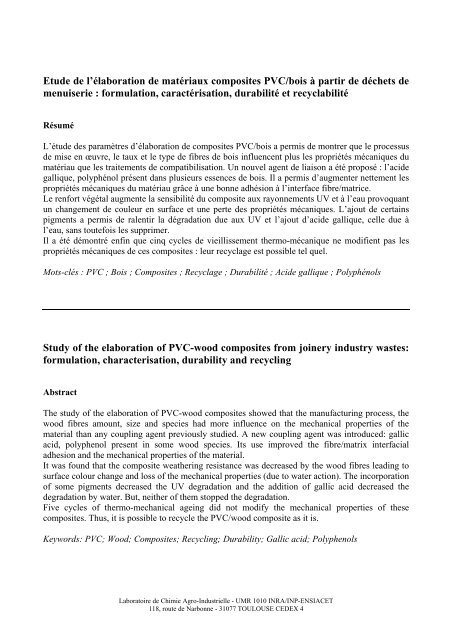Etude de l'élaboration de matériaux composites PVC/bois à partir de ...
Etude de l'élaboration de matériaux composites PVC/bois à partir de ...
Etude de l'élaboration de matériaux composites PVC/bois à partir de ...
Create successful ePaper yourself
Turn your PDF publications into a flip-book with our unique Google optimized e-Paper software.
<strong>Etu<strong>de</strong></strong> <strong>de</strong> l’élaboration <strong>de</strong> matériaux <strong>composites</strong> <strong>PVC</strong>/<strong>bois</strong> à <strong>partir</strong> <strong>de</strong> déchets <strong>de</strong><br />
menuiserie : formulation, caractérisation, durabilité et recyclabilité<br />
Résumé<br />
L’étu<strong>de</strong> <strong>de</strong>s paramètres d’élaboration <strong>de</strong> <strong>composites</strong> <strong>PVC</strong>/<strong>bois</strong> a permis <strong>de</strong> montrer que le processus<br />
<strong>de</strong> mise en œuvre, le taux et le type <strong>de</strong> fibres <strong>de</strong> <strong>bois</strong> influencent plus les propriétés mécaniques du<br />
matériau que les traitements <strong>de</strong> compatibilisation. Un nouvel agent <strong>de</strong> liaison a été proposé : l’aci<strong>de</strong><br />
gallique, polyphénol présent dans plusieurs essences <strong>de</strong> <strong>bois</strong>. Il a permis d’augmenter nettement les<br />
propriétés mécaniques du matériau grâce à une bonne adhésion à l’interface fibre/matrice.<br />
Le renfort végétal augmente la sensibilité du composite aux rayonnements UV et à l’eau provoquant<br />
un changement <strong>de</strong> couleur en surface et une perte <strong>de</strong>s propriétés mécaniques. L’ajout <strong>de</strong> certains<br />
pigments a permis <strong>de</strong> ralentir la dégradation due aux UV et l’ajout d’aci<strong>de</strong> gallique, celle due à<br />
l’eau, sans toutefois les supprimer.<br />
Il a été démontré enfin que cinq cycles <strong>de</strong> vieillissement thermo-mécanique ne modifient pas les<br />
propriétés mécaniques <strong>de</strong> ces <strong>composites</strong> : leur recyclage est possible tel quel.<br />
Mots-clés : <strong>PVC</strong> ; Bois ; Composites ; Recyclage ; Durabilité ; Aci<strong>de</strong> gallique ; Polyphénols<br />
Study of the elaboration of <strong>PVC</strong>-wood <strong>composites</strong> from joinery industry wastes:<br />
formulation, characterisation, durability and recycling<br />
Abstract<br />
The study of the elaboration of <strong>PVC</strong>-wood <strong>composites</strong> showed that the manufacturing process, the<br />
wood fibres amount, size and species had more influence on the mechanical properties of the<br />
material than any coupling agent previously studied. A new coupling agent was introduced: gallic<br />
acid, polyphenol present in some wood species. Its use improved the fibre/matrix interfacial<br />
adhesion and the mechanical properties of the material.<br />
It was found that the composite weathering resistance was <strong>de</strong>creased by the wood fibres leading to<br />
surface colour change and loss of the mechanical properties (due to water action). The incorporation<br />
of some pigments <strong>de</strong>creased the UV <strong>de</strong>gradation and the addition of gallic acid <strong>de</strong>creased the<br />
<strong>de</strong>gradation by water. But, neither of them stopped the <strong>de</strong>gradation.<br />
Five cycles of thermo-mechanical ageing did not modify the mechanical properties of these<br />
<strong>composites</strong>. Thus, it is possible to recycle the <strong>PVC</strong>/wood composite as it is.<br />
Keywords: <strong>PVC</strong>; Wood; Composites; Recycling; Durability; Gallic acid; Polyphenols<br />
Laboratoire <strong>de</strong> Chimie Agro-Industrielle - UMR 1010 INRA/INP-ENSIACET<br />
118, route <strong>de</strong> Narbonne - 31077 TOULOUSE CEDEX 4

















